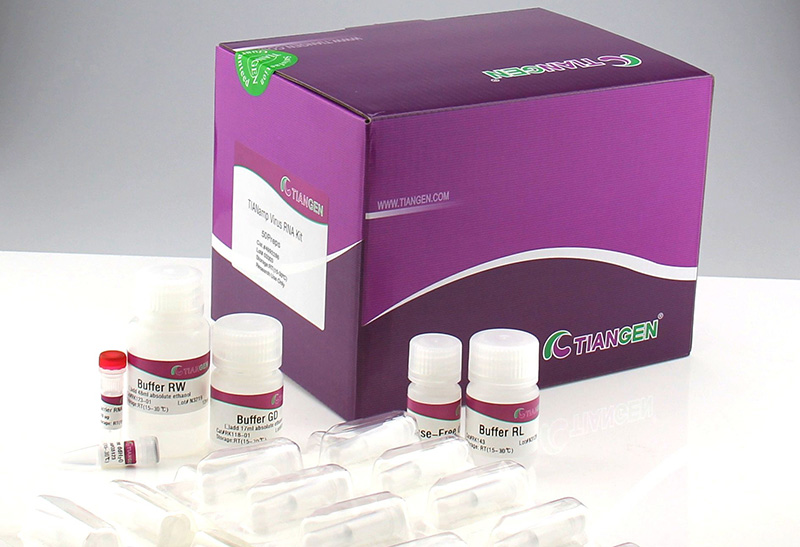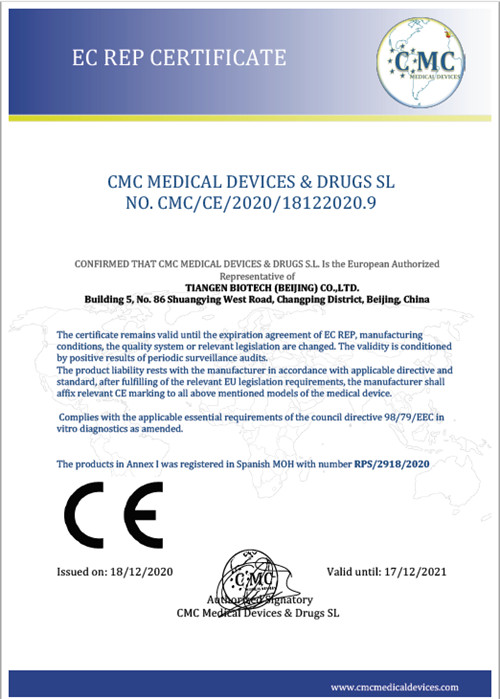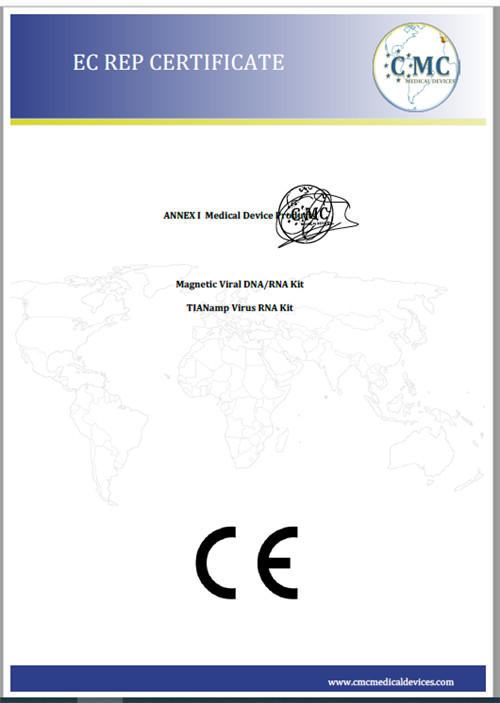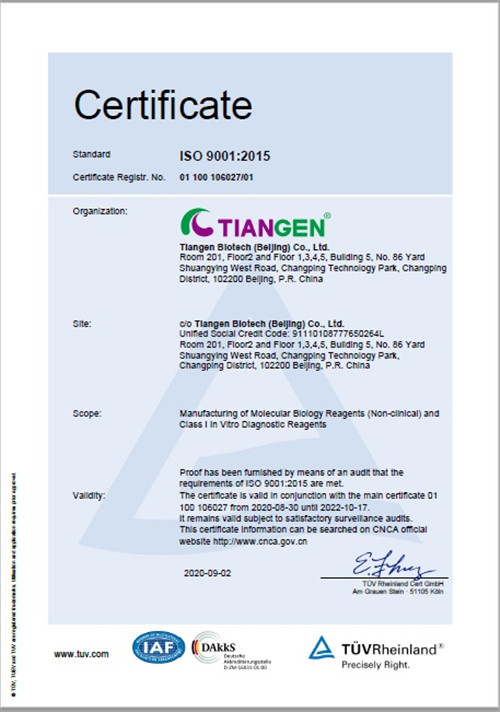Good quality Rna Extraction Silica Column - TIANamp Virus RNA Kit – TIANGEN
Good quality Rna Extraction Silica Column - TIANamp Virus RNA Kit – TIANGEN Detail:
Storage
EasyGeno assembly cloning kit should be stored at -20°C. Avoid repeated freezing and thawing. The shelf life is one year.
EasyGeno Assembly Cloning Kit joins DNA fragments in a one-step isothermal reaction, only for 15 min at 50°C.
Features
■ High-quality virus RNA can be obtained within one hour.
■ No phenol/chloroform extraction and ethanol precipitation are needed.
■ High RNA yield and excellent repeatability.
■ Complete removal of contaminants and inhibitors, facilitating downstream applications.
Required Reagents
Ethanol, DNase I (optional)
Applications
■ Virus genotyping research.
■ Virus epidemiologic study.
■ Virus infectious diseases analysis.
FAQ
Q:Little or no DNA in the eluent.
A-1 Low concentration of cells or virus in the starting sample
—Enrich the concentration of cells or viruses.
A-2 Insufficient lysis of the samples
—The samples has not been mixed thoroughly with the lysis buffer. It is suggested to thoroughly mix by pulse-vortexing for 1-2 times.
—Insufficient cell lysis caused by the activity decrease of proteinase K.
—Insufficient cell lysis or protein degradation due to insufficient warm bath time. It is suggested to cut the tissue into small pieces and extend the bath time to remove all the residue in the lysate.
A-3 Insufficient DNA adsorption.
—No ethanol or low-percentage instead of 100% ethanol was added before the lysate was transfer to the spin column.
A-4 The pH value of elution buffer is too low.
—Adjust the pH to between 8.0-8.3.
Q:DNA does not perform well in downstream enzymatic reaction experiments.
Residual ethanol in the eluent.
—There is residual washing buffer PW in the eluent. The ethanol can be removed by centrifuging the spin column for 3-5 min, and then placing at room temperature or 50℃ incubator for 1-2 min.
Q:DNA degradation
A-1 The sample is not fresh.
—Extract a positive sample DNA as control to determine whether the DNA in the sample has degraded.
A-2 Improper pre-treatment.
—Caused by excessive liquid nitrogen grinding, moisture regaining, or too large amount of the sample.
Q:How to perform the pretreatment for gDNA extraction?
The pretreatments should vary for different samples. For plant samples, make sure to thoroughly grind in liquid nitrogen. For animal samples, homogenate or thoroughly grind in liquid nitrogen. For samples with cell walls that are hard to break, such as G+ bacteria and yeast, it is suggested to use lysozyme, lyticase or mechanical methods to break the cell walls.
Q:What is the difference between the three plant gDNA extraction kits 4992201/4992202, 4992724/4992725, 4992709/4992710?
4992201/4992202 Plant Genomic DNA Kit adopts a column-based method that requires chloroform for the extraction. It is especially suitable for various plant samples, as well as plant dry powder. Hi-DNAsecure Plant Kit is also column-based, but with no need of phenol/chloroform extraction, making it safe and non-toxic. It is suitable for plants with high polysaccharides and polyphenol content. 4992709/4992710 DNAquick Plant System adopts a liquid-based method. Phenol/chloroform extraction is not needed as well. The purification procedure is simple and fast with no limit for the sample start amounts, so users can adjust the amount flexibly according to the experimental requirements. Large size of gDNA fragments can be obtained with high yield.
Q:What’s the estimated yield of gDNA from 1 ml blood sample by TIANamp Blood DNA Kit?
The genomic DNA was extracted from different volumes of human whole blood samples by TIANamp Blood DNA Kit. The results are as follow. The results are listed as reference only, the actual extraction results depends on the conditions of samples.

Q:Can 4992207/4992208 and 4992722/4992723 be used to extract blood clots DNA?
The blood clot DNA extraction can be performed using the reagents provided in these two kits by simply changing the protocol to the specific instruction for the blood clot DNA extraction. The soft copy of the blood clot DNA extraction protocol can be issued upon requesting.
Q:When applying TIANamp Genomic DNA Kit, how to break the fresh tissues into cell suspension?
Suspend the fresh sample with 1 ml PBS, normal saline or TE buffer. Completely homogenize the sample by a homogenizer and collect the precipitate to the bottom of a tube by centrifuging. Dispose the supernatant, and resuspend the precipitate with 200 μl buffer GA. The following DNA purification can be performed according to the instruction.
Q:How to choose the product for the DNA extraction from plasma, serum and body fluid samples?
For the purification of gDNA in plasma, serum and body fluid samples, TIANamp Micro DNA Kit is recommended. For the purification of virus gDNA from serum/plasma samples, TIANamp Virus DNA/RNA Kit is recommended. For the purification of bacterial gDNA from serum and plasma samples, TIANamp Bacteria DNA Kit is recommended (lysozyme should be included for positive bacterial). For saliva samples, Hi-Swab DNA Kit and TIANamp Bacteria DNA Kit are recommended.
Q:How to choose the kits for the gDNA extraction from fungi samples?
DNAsecure Plant Kit or DNAquick Plant System are recommended for fungal genome extraction. For yeast genome extraction, TIANamp Yeast DNA Kit is recommended (lyticase should be self-prepared).
Product detail pictures:

Related Product Guide:
Our primary intention should be to offer our clientele a serious and responsible enterprise relationship, delivering personalized attention to all of them for Good quality Rna Extraction Silica Column - TIANamp Virus RNA Kit – TIANGEN , The product will supply to all over the world, such as: Surabaya, Jamaica, Portugal, We've been consistently broadening the market within Romania in addition to preparation punching in extra premium quality merchandise connected with printer on t shirt so that you can Romania. Most people firmly believe we've the whole capacity to provide you happy solutions.
The company's products very well, we have purchased and cooperated many times, fair price and assured quality, in short, this is a trustworthy company!
Products categories
WHY CHOOSE US
Since its establishment, our factory has been developing first world class products with adhering the principle
of quality first. Our products have gained excellent reputation in the industry and valuabletrusty among new and old customers..








